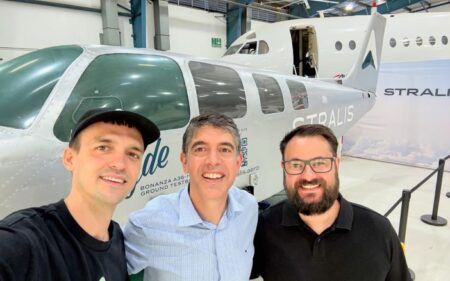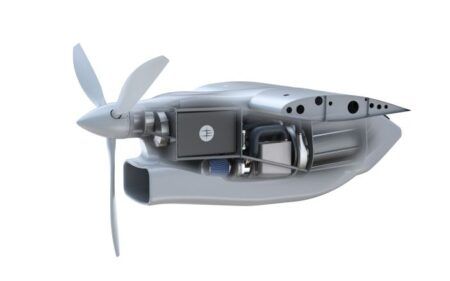The first prototype 500KW electric motor that will be used on Hybrid Air Vehicles’ Airlander 10 airship has been completed and started ground testing.
The motor, which has been developed by Collins Aerospace and the University of Nottingham, is being tested at the University’s recently-opened £7.6 million (US$9 million) national Electrification of Aerospace Propulsion Facility (UKEAPF) test facility. Collins has begun basic characterization testing of the motor.
The 500kW motor will be fitted to the Airlander 10 in 2026 and by 2030 all of the gas turbines on the airship will be replaced with electric motors.
UK-based Hybrid Air Vehicles (HAV) plans to begin regional passenger-carrying services with the Airlander 10 in 2026.
The company recently received an order for the first Airlander 10s from Spanish regional airline Air Nostrum Líneas Aereas.
The Airlander 10 will carry up to 100 passengers, have a range of 4,600 miles (7,400km), a top speed of around 85mph (km/h) and will be able to stay airborne for up to five days. The Airlander has been in development since 2007.
The company has also recently set out plans to develop Airlander 50, a larger version for freight applications which it plans to enter service by 2030
According to HAV, the Airlander 10 achieves 90% fuel emissions reduction compared to equivalent aircraft. The motors will be paired with a hydrogen fuel cell system which will result in a version of the Airlander 10 that produces zero fuel emissions.
Speaking at the Farnborough Airshow, Tom Grundy, CEO of Hybrid Air Vehicles said, “We are bringing the world’s most efficient large aircraft onto the market
“This is a major part of what we must do to decarbonize our operations. It will also help offer services to customers in underserved parts of the world.”
Eric Cunningham, vice president, electric power systems at Collins Aerospace said, “This project is amazing and we are excited to be partners with Airlander.
“A lot of aerospace companies are talking about sustainability, but this company is doing it. They will have a launch vehicle in their class that will introduce electric propulsion to the industry.”
Collins’ engineers are targeting power density levels of nine kilowatts per kilogram for the 2,000 RPM permanent magnet motor and 98% efficiency, through the use of a novel motor topology and composite construction. The company is designing the motor at its facility in Solihull, UK, where it is also developing a 1MW electric motor for a Pratt & Whitney hybrid-electric regional aircraft demonstrator.
“The big difference is the scale and the power density of these motors. Motors on aircraft today get up to around 70kW, these will start at 500kW, it’s another level of power,” added Cunningham.
“From a propulsion standpoint the power density is key, once you have achieved that you need to be able to make in a mass manufacturing environment.”
Hitendra Hirani, programme manager at the University of Nottingham said, “This motor is zero carbon technology and one of the first projects to go through the UK’s electric aircraft propulsion at the University of Nottingham.
“We have been able to test this motor and do a lot of ground tests to derisk the development and get the aircraft to market faster and that perform reliably.
“We dug a 5MVa electrical feed into the electrical subsystem so that we have our own feed coming in to the building for the test rig. We have 22MW circulating within the building with all the necessary equipment need to test these motors reliably on the ground. Soon we will be unveiling the outdoor test facility so we can test it in the real flight conditions.





